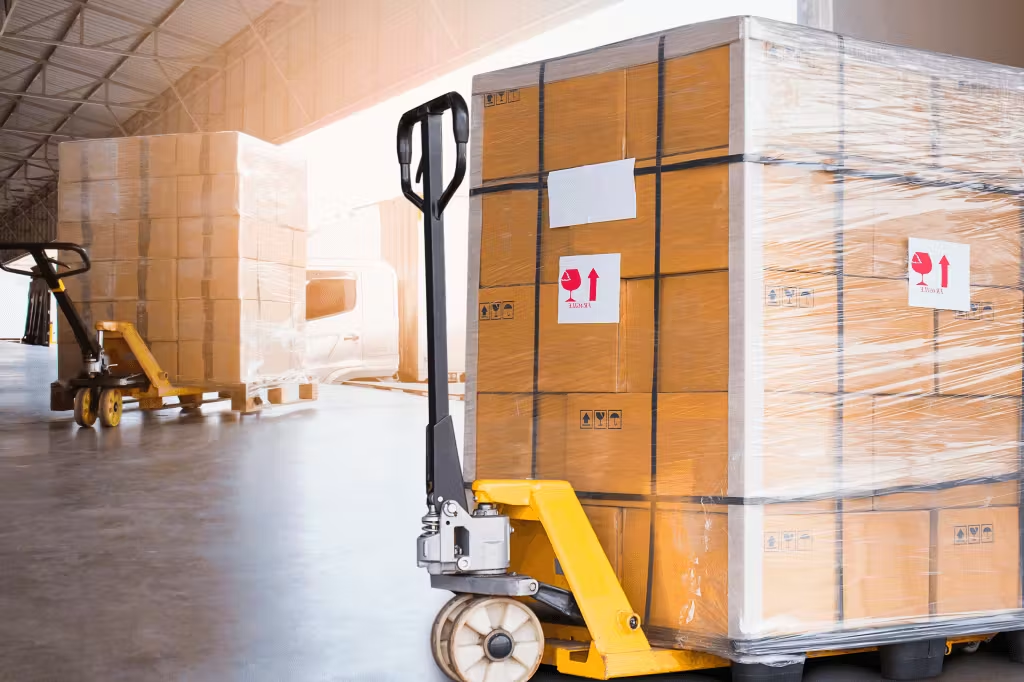Line Haul Transportation: 5 Benefits for Shippers

Ship your freight faster.
Move your freight right now. Thousands of trustworthy trucking partners are waiting.
If you are a freight shipper, you likely need a carrier to move your goods. Line haul, or linehaul, transportation is one method of moving items between cities that are fairly far apart. Rather than loading your goods onto one truck where they will remain for the trip’s entirety, think of line haul services as a relay that may involve multiple modes of transport. Each truck, ship, or railroad completes one leg of the relay, and your goods travel between different depots and sorting facilities.
Linehaul transportation has quite a few benefits for shippers. But what exactly is linehaul transportation? What is a linehaul driver or a linehaul carrier? And what can you expect from the process? Let’s dig deeper into this type of shipping and why it may make sense for you.
What is line-haul transportation?
As noted above, linehaul transportation is a sort of relay. Goods from multiple shippers going to roughly the same area are consolidated and sent to depots and sorting facilities for sorting and reconsolidation. Your goods may visit several facilities en route to their final destination.
This process means that line haul optimization is integral to transportation logistics. Your line-haul carrier takes charge of all the moving pieces. They ensure your goods get to their destination on time and within budget, regardless of how many modes of transportation are involved or how many times they are reconsolidated.
Key areas of line haul services
There are five critical areas of linehaul services. Each is vital to making the entire system work smoothly, so it’s crucial to choose a skilled linehaul carrier experienced in each service.
Movement of freight between cities
This is the main element of linehaul transportation. The whole point is to efficiently move goods from one city to another, regardless of how far apart the origin and destination might be.
Delivery duration
Line haul logistics are designed to be efficient and minimize the time it takes for your goods to reach their final destination. Line haul carriers use digital tools and data analytics to optimize delivery routes and move goods as quickly and efficiently as possible.

Movement of goods/packages to and from depots
A depot, or warehouse, is typically the first stop for your shipment. The original truck (or ship or railroad car) is unloaded alongside many others, and your goods are reconsolidated with other items headed in the same direction. There may be several depots along the route.
Movement of goods/packages to and from sorting facilities
As your items get closer to their final destination, they will pass through one or more sorting facilities. These massive centers may sort goods based on multiple criteria, from the type of goods to their specific destination.
Transportation costs
Of course, transportation costs are critical to nearly every freight shipper. A primary part of line haul optimization is keeping the costs as low as possible. By combining your goods with others in various ways, line-haul carriers can keep trucks full and goods moving, reducing overall costs.
Line haul vs. long haul trucking
At first glance, line haul trucking and long haul trucking might seem similar. So what is the difference between line haul versus long haul trucking?
Long haul truckers spend days or even weeks on the road hauling a single truckload from its origin city to its destination city. Line haul truckers work in shifts. Each has a dedicated portion of the route, transporting goods back and forth between specific depots and/or sorting facilities. They go home each night, reducing costs and driver fatigue.
5 advantages of line haul trucking
Line haul trucking offers several advantages for shippers. These include the following.
1. Better 3PL/carrier management
Communication matters, whether you work with a 3PL (third-party logistics) company or directly with carriers. Line haul optimization relies on the latest tools and technologies to streamline processes and keep the lines of communication open. You can take advantage of powerful data analytics to better manage all of your deliveries.
2. Reduced trucking costs
Linehaul trucking relies on a series of drivers traveling shorter routes between facilities. There are no hotel bills or other overnight costs. Truckers don’t need to wait until they have a full truckload or take off only partially loaded. Consolidating and reconsolidating goods allows linehaul carriers to optimize their operations and lower costs, ultimately passing the savings to you.
3. Increased delivery production
Data tracking, analytics, and ongoing optimization vastly improve efficiency. Line haul carriers can deliver more goods in the same amount of time, which translates into actual time and money savings for freight shippers.
4. Faster deliveries
Constant data tracking and real-time analysis allow linehaul carriers to spot and address issues as they arise. Whether a particular road is experiencing delays or a specific port is unusually congested, linehaul drivers receive regular updates with suggestions for alternate routes to save time. The net result is deliveries that are less likely to get bogged down, arriving faster in many cases than traditional long-haul deliveries.
5. Enhanced delivery experience
Customer service is critical for businesses trying to build brand loyalty, and today’s customers have high expectations. They want to track their deliveries and receive them promptly. Partnering with a line haul carrier creates an open, transparent delivery experience that can help keep your customers happy.
5 line haul optimization tips
Line haul carriers must do several things to ensure that their operations are continually optimized. Any line haul carrier you partner with should do the following:
Keep detailed records.
A good linehaul carrier knows that optimization depends on details. Choose a carrier that keeps records of every delivery, from the driver’s name and destination to the delivery time and shipment weight. Carriers should also know the individual capacities of every vehicle, depot, and sorting facility. These details allow carriers to make the best decisions for each load.
Reward drivers.
Drivers are the lifeblood of a linehaul carrier’s chain. Look for a carrier that boosts productivity by rewarding drivers for their efforts. Competitive salaries, benefits, and performance bonuses help ensure you’re getting genuinely motivated drivers.
Keep customers informed.
Ultimately, it’s your company name on the delivery. If customers are unhappy with the delivery experience, it could wreak havoc on your business. Choose a linehaul carrier with an excellent track record in customer service. They should be transparent about expected delivery times, delays, and any other details that could affect the customer experience.
Identify optimal routes.
Line haul transportation frequently involves multiple modes of transportation, including trucks, ships, and railroads. It also moves goods between several different facilities. The best line haul carriers know how to identify optimal routes for each load, regardless of size or type.
Use the right software.
Digital tracking and data analytics are critical to successful optimization. Be sure that your linehaul carrier is fully equipped with the latest tools and technologies and knows how to use them to develop the best routes.

Line haul trucking rates
Line haul rates are typically priced by the mile. You may sometimes see them referred to as CPM, or cost per mile. You might also notice additional fees for extra services, known as accessorial charges. However, these fees are more common with other types of shipping.
Why line haul rates vary
If you have priced out linehaul services for multiple shipments, you may have noticed that linehaul rates can vary dramatically. These fluctuations result from a few factors that are largely beyond your control.
- Origin and destination cities:As a general rule, you can expect to pay more to transport goods further. You may pay less for line haul trucking than long haul trucking, but it will still cost more to ship items from California to New York than from Sacramento to San Diego.
- Type of goods:Not only will you pay more to ship heavier or bigger goods, but you will pay a premium for items that require special handling, such as Hazmat materials.
- Seasonality:Like any other business, the shipping industry experiences seasonal changes. Shipping during a prime season such as the winter holidays typically costs more than shipping at a slower time of year.
- Load-to-truck ratios:Freight rates typically rise when there are more loads than available trucks in a particular lane. When there are a lot of trucks and fewer loads, rates generally go down.
- Outside factors:The global pandemic wreaked havoc on supply chains, causing a trickle-down effect throughout the entire transportation industry. Even smaller issues, such as an unusually congested port, could also affect rates in a surprisingly large area.
Fortunately, you don’t have to guess at freight rates. If you’re wondering how to determine optimal rail line haul rates, or any other line haul rates, the Truckstop Rate Insights tool can help. You can view spot rates and 4-week and 36-week trends, all filtered according to the details of your load.
How to calculate (& find) the best rates
Instead of a rate per mile, you might be quoted a total rate for the shipment. You can calculate the rate per mile by simply dividing the total rate by the total mileage.
All truckers have a base rate, the least they can charge to break even. It differs for everyone because it depends on each trucker’s fixed and variable costs. Above that base rate, there may be room to negotiate linehaul costs, depending on the factors noted above. The Truckstop Rate Insights tool will help you understand both current and historic rate trends, allowing you to negotiate from a place of strength.
Importance of line haul carrier tracking
Line haul carrier tracking is ultimately what drives the entire business. It offers enhanced visibility for customers, shippers, and truckers. It allows carriers to make decisions on the fly when issues arise. And tracking also gathers and analyzes a great deal of data to provide insights into new opportunities for optimization. For example, the carrier might compare the transit times of a ship traveling upriver versus a truck driving the coastal highway. This information could help the carrier decide which mode of transportation to use for that particular route.
Find quality line haul carriers and ship freight faster.
Line haul transportation is an excellent choice for many freight shippers. But you need to be able to find the right line haul carrier for the job. The Truckstop Load Board for Shippers lets you post loads and access highly qualified, fully vetted line haul carriers ready to move your goods. You’ll also gain access to a full suite of tools to help you negotiate the best rates and make the right decisions for your business.
Get helpful content delivered to your inbox.
Sign up today.
Find high-quality loads fast, get higher rates on every haul, and access tools that make your job easier at every turn.






